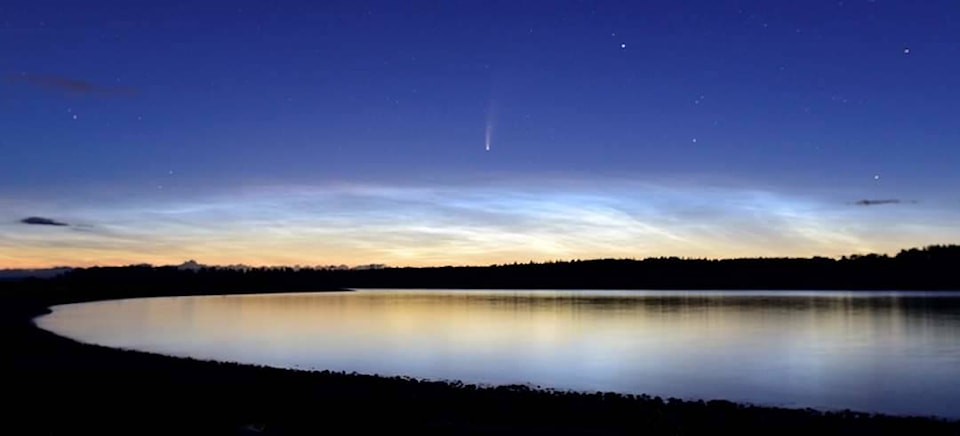As an avid astro-photographer for more than 12 years, James Younger of Central Saanich is more than familiar when it comes to being up at late hours to get the right shots.
But as Younger prepares to spend many hours in the coming days and weeks to capture the comet NEOWISE with his camera, he is far from complaining, especially, if that opportunity comes around only every 7,000 years or so.
The comet has become increasingly visible in northern latitudes and Younger went down to the beach in Island View Park in the early morning hours of Monday (July 13) to take some of the very first pictures of the comet appearing over the Saanich Peninsula’s sky, as it become visible here.
“I found this celestial event awe-inspiring,” he said. “I have photographed lunar eclipses, solar eclipses, auroras, and I have found that this was the most excited I have been for a long time.”
For one, NEOWISE is the biggest comet that he has seen and photographed. It is also something that appears in the sky without any run-up. “For an aurora, you can go out, wait all night and nothing will happen,” he said. “For this, as soon as you got down to the beach, you can see it as plain as day.”
This visibility will only increase as the comet gets closer to Earth with astronomers identifying July 22-23 as the day when the two celestial bodies will be closest to each other, with the comet passing at a distance of some 103 million kilometres, according to earthsky.org.
RELATED: Photographer captures Perseid meteor shower over Shuswap
It will also get much darker as the moon’s luminescence decreases, said Younger. “We are currently at 75 per cent, but as the moon gets down to zero, it’s going to be much darker and the tail should also be brighter and bigger. So it should get better over the next two weeks.”
What also makes the comet special is its relative sudden appearance. Modern-day astronomers (and the rest of humanity along with them) generally know well in advance when comets pass through the solar system. But astronomers only discovered NEOWISE on March 27. “This one came on really, really, really fast. No one knew it was going to happen,” he said.
In other words, it literally came out of the dark, and it won’t reappear again for another 7,000 years. To put this into historical context, the last time NEOWISE appeared in the sky, humans living in the Middle East had just entered the Neolithic age characterized by the domestication of animals, the emergence of settled communities and increasingly sophisticated societal structures, with the proviso that the rest of humanity were still largely living as hunters and gatherers as they had done for tens of thousands of years before. Familiar monumental pieces of architecture from this Neolithic period such as Stonehenge, as well as the pyramids in Egypt and Mesoamerica would not appear for several thousand years.
In other words, watching this comet represents a once-in-a-civilization moment and Younger encourages others to take advantage of the opportunity.
“It’s awe-inspiring,” he said. “It’s really quite breathtaking.”
Like us on Facebook and follow @wolfgang_depner
